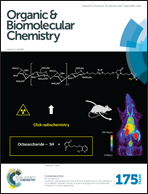Triflate-functionalized calix[6]arenes as versatile building-blocks: application to the synthesis of an inherently chiral Zn(ii) complex†
Abstract
Cavity-based metal complexes can find many applications notably in the fields of catalysis and biomimicry. In this context, it was shown that metal complexes of calix[6]arenes bearing three aza-coordinating arms at the small rim provide excellent structural models of the poly-imidazole sites found in the active site of many metallo-enzymes. All these N-donor ligands were synthesized from the 1,3,5-tris-methoxy-p-tBu-calix[6]arene platform, which presents some limitations in terms of functionalization. Therefore, there is a need for the development of new calix[6]arene-based building-blocks selectively protected at the small rim. Herein we describe the regioselective one step synthesis of two calix[6]arenes decorated with triflate groups, i.e. X6H4Tf22 and X6H3Tf33, from the parent calix[6]arene X6H61. It is shown that the triflate groups can either act as protecting or deactivating groups, allowing the elaboration of sophisticated calixarene-based systems selectively functionalized at the large and/or at the small rim. In addition, X6H3Tf33 is functionalized on the A, B, and D rings and thus gives access to inherently chiral compounds, as demonstrated by the synthesis of a rare example of inherently chiral cavity-based metal complex.
![Graphical abstract: Triflate-functionalized calix[6]arenes as versatile building-blocks: application to the synthesis of an inherently chiral Zn(ii) complex](/en/Image/Get?imageInfo.ImageType=GA&imageInfo.ImageIdentifier.ManuscriptID=C5OB02367J&imageInfo.ImageIdentifier.Year=2016)


 Please wait while we load your content...
Please wait while we load your content...